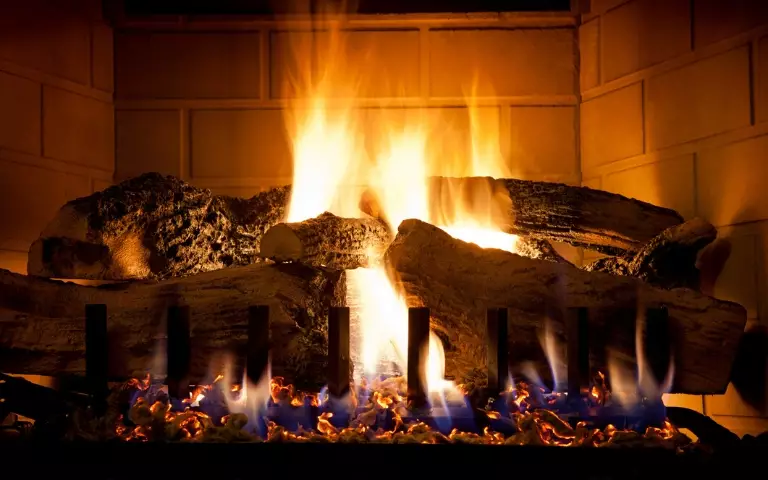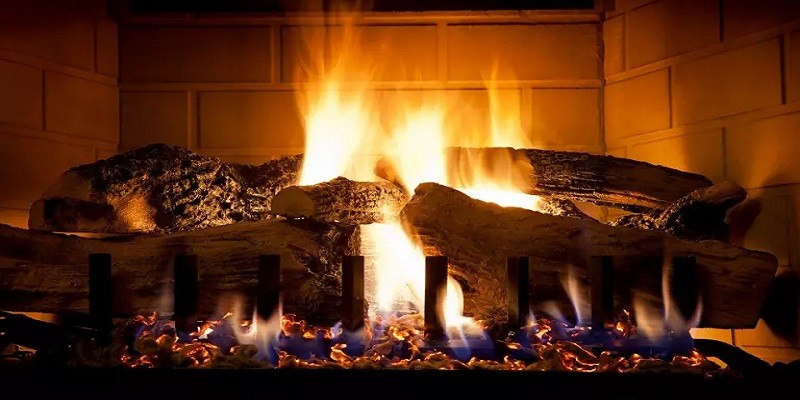Last Updated on September 12, 2023
To clean gas fireplace logs, remove them from the fireplace and gently brush off any loose debris. Then, wipe the logs with a damp cloth or sponge dipped in a mixture of mild soap and water.
The Importance Of Cleaning Gas Fireplace Logs
Understanding the importance of cleaning gas fireplace logs is crucial for maintaining their efficiency and preventing potential hazards. To clean gas fireplace logs, begin by removing any dust and debris using a soft brush. Then, wipe the logs with a damp cloth and mild soap solution, ensuring they are completely dry before reassembling.
Gas fireplace logs are a key component of your fireplace and play a crucial role in creating a warm and cozy ambiance. However, many people overlook the importance of cleaning these logs regularly. Neglecting gas fireplace log cleaning can have detrimental effects, both on the aesthetics of your fireplace and on the overall functionality of the unit.
In this section, we will explore why regular cleaning is necessary for gas fireplace logs and the potential consequences of neglecting this crucial maintenance task.
Why Regular Cleaning Is Necessary For Gas Fireplace Logs:
- Ensures optimal performance: Over time, gas fireplace logs can accumulate dust, debris, and soot, which can hinder their performance. Regular cleaning removes these contaminants, allowing the logs to burn efficiently and distribute heat effectively.
- Enhances safety: Gas fireplace logs can become dirty and clogged, leading to poor combustion and the production of harmful gases like carbon monoxide. Cleaning the logs on a regular basis reduces the risk of gas leaks, potential fires, and the associated health hazards.
- Preserves the aesthetic appeal: Dirty gas fireplace logs can have a negative impact on the overall appearance of your fireplace. Soot and grime can accumulate on the logs, leading to a dark, unattractive appearance. Cleaning the logs restores their natural beauty, allowing you to fully enjoy the visual allure of a flickering fire.
- Extends the lifespan of the logs: Regular cleaning helps to prolong the lifespan of gas fireplace logs. The accumulation of debris and soot can cause premature wear and tear, affecting the durability and functionality of the logs. By keeping them clean, you can ensure that your logs last longer and provide you with many cozy fireside evenings.
Effects Of Neglecting Gas Fireplace Log Cleaning:
- Reduced efficiency: When gas fireplace logs are covered in dust and soot, they struggle to burn effectively. This results in reduced efficiency and heat output, leaving you with a less cozy and comforting fire.
- Increased risk of gas leaks: Neglected gas logs can develop cracks or leaks, leading to the release of gas into your home. This poses a serious safety hazard, as gas leaks can cause fires, explosions, and even health complications.
- Aesthetically unpleasing: Dirty gas logs can quickly detract from the overall beauty of your fireplace. Soot and grime accumulate, giving the logs a dull and dark appearance, which takes away from the charm and ambiance of the fire.
- Impaired ventilation: A buildup of dirt and debris on the gas logs can obstruct the ventilation system of your fireplace. This can lead to poor air circulation, increased indoor pollutants, and potential breathing difficulties for you and your family.
Regularly cleaning your gas fireplace logs is vital for maintaining their performance, safety, and visually appealing qualities. By dedicating a small amount of time and effort to this maintenance task, you can ensure that your fireplace continues to provide warmth, comfort, and a cozy atmosphere for years to come.

Credit: www.carolinacomfortair.com
Gathering The Essential Tools And Materials
To clean gas fireplace logs effectively, gather the essential tools and materials needed for the task. Ensure you have a soft brush, vacuum cleaner, mild detergent, warm water, and a cloth to remove any dirt or residue from the logs.
Gas fireplace logs are a beautiful and convenient addition to any home. However, regular maintenance and cleaning are essential to keep them looking their best and functioning efficiently. In this section, we will discuss the tools and materials you’ll need to effectively clean your gas fireplace logs.
Tools Needed For Cleaning Gas Fireplace Logs:
- Soft-bristle brush: A soft-bristle brush is ideal for gently removing dirt, dust, and soot from the surface of your gas fireplace logs. Make sure the brush is specifically designed for fireplace use to prevent damaging the logs.
- Vacuum cleaner with brush attachment: A vacuum cleaner with a brush attachment is perfect for removing loose debris from your gas fireplace logs. The brush attachment helps to avoid scratches and ensures a thorough clean.
- Microfiber cloth: A microfiber cloth is excellent for wiping down the logs and getting rid of any remaining dust or grime. Its soft texture helps to avoid scratching the logs.
- Gloves: Wearing gloves during the cleaning process is crucial to protect your hands from dirt, soot, and any cleaning products you may use.
Materials Required For A Thorough Cleaning Process:
- Mild soap or cleaning solution: Using a mild soap or cleaning solution specifically designed for fireplace use will effectively clean your gas fireplace logs without damaging them. Avoid using harsh chemicals that could discolor or deteriorate the logs.
- Distilled water: Distilled water is preferable to tap water as it contains fewer impurities, which can leave behind unwanted residue on your gas fireplace logs.
- Bucket or container: Fill a bucket or container with a mixture of mild soap or cleaning solution and distilled water to create a gentle cleaning solution.
- Protective covering: To safeguard the surrounding area of your gas fireplace logs, lay down a protective covering such as newspapers, plastic sheets, or a drop cloth to catch any cleaning solutions or debris that may fall.
With these essential tools and materials, you are well-prepared to clean your gas fireplace logs effectively. Now, let’s move on to the next section to learn about the step-by-step cleaning process. Stay tuned!
Cleaning The Gas Fireplace Logs
Want to know how to clean your gas fireplace logs? Follow these simple steps to keep them looking fresh and functioning efficiently. Keep your gas fireplace logs clean to enjoy a cozy and efficient fire all winter long.
Step 1: Preparing The Fireplace And Ensuring Safety
- Before cleaning the gas fireplace logs, ensure that the gas supply is turned off and the fireplace is cool to the touch.
- Put on protective gloves and safety goggles to prevent any injuries while cleaning.
Step 2: Removing The Logs And Cleaning The Exterior
- Carefully remove the gas logs from the fireplace, following the manufacturer’s instructions.
- Use a soft brush or cloth to wipe away any dirt or debris from the exterior of the logs.
- For tougher stains, you can use warm water and mild soap solution, but avoid using abrasive cleaners that could damage the surface of the logs.
Step 3: Cleaning The Interior Of The Gas Fireplace Logs
- Use a small handheld vacuum or brush attachment to remove any dust or debris from the interior of the gas logs.
- Gently brush away any cobwebs or loose particles that may have accumulated.
- Avoid using water or liquid cleaners on the interior of the logs, as it can cause damage to the gas burner or electrical components.
Step 4: Dealing With Stubborn Stains Or Debris
- If there are stubborn stains or debris on the gas logs, you can try using a soft bristle brush to gently scrub the affected areas.
- For particularly stubborn stains, a mixture of baking soda and water can be applied to the stain, left to sit for a few minutes, and then gently scrubbed away.
- Be cautious not to apply excessive pressure or use abrasive materials that can scratch or damage the logs.
Step 5: Reassembling The Logs And Restoring The Fireplace’S Appearance
- Once the gas logs are clean and dry, carefully reassemble them in the correct order as per the manufacturer’s instructions.
- Check for any loose connections or signs of damage before turning the gas supply back on.
- Lastly, use a soft cloth to wipe down the exterior of the logs to restore their appearance and remove any remaining dust or residue.
Following these steps will help you effectively clean gas fireplace logs, ensuring a safe and efficient fireplace experience. Regular maintenance and cleaning will keep your gas fireplace looking its best and functioning properly.
Essential Maintenance Tips For Gas Fireplace Logs
Gas fireplace logs require regular cleaning to maintain their efficiency and performance. Follow these essential maintenance tips to keep your gas fireplace logs in excellent condition and enjoy a cozy, warm atmosphere in your home.
Gas fireplace logs are a convenient and cozy way to add warmth and ambiance to your home. However, just like any other appliance, they require regular maintenance to ensure they function properly and last for years to come. In this section, we will explore essential maintenance tips for gas fireplace logs, including a regular inspection and cleaning schedule, dos and don’ts to prolong their lifespan, and safety precautions to follow during and after cleaning.
Regular Inspection And Cleaning Schedule
To keep your gas fireplace logs in optimal condition, it is important to follow a regular inspection and cleaning schedule. Here are a few key steps to include in your maintenance routine:
- Inspect the logs: Regularly check the logs for any signs of wear, damage, or debris buildup. Look for cracks, discoloration, or loose connections.
- Clean the logs: Use a soft brush or cloth to gently remove dust, dirt, and soot from the surface of the logs. Avoid using abrasive materials or cleaners that could damage the logs.
- Check the burner: Inspect the burner to ensure it is free from any blockages or debris that could affect the performance of the gas fireplace logs. If you notice any issues, such as uneven flames or difficulty igniting the logs, it may be necessary to clean or unclog the burner.
- Test the ignition system: Regularly test the ignition system to ensure it is functioning properly. Follow the manufacturer’s instructions for testing and troubleshooting any issues.
Dos And Don’Ts To Prolong The Lifespan Of Gas Fireplace Logs
Taking proper care of your gas fireplace logs can help prolong their lifespan and ensure safe operation. Here are some dos and don’ts to keep in mind:
Dos:
- Do read and follow the manufacturer’s instructions for installation, use, and maintenance of your gas fireplace logs.
- Do have your gas fireplace logs professionally inspected and serviced at least once a year to ensure they are functioning safely and efficiently.
- Do use a carbon monoxide detector in the same room as your gas fireplace logs to monitor for any potential gas leaks or ventilation issues.
- Do clean the logs and burner regularly to prevent buildup of debris, which could affect the flames and heat output.
Don’ts:
- Don’t use abrasive materials or harsh cleaners to clean the logs, as this can damage the surface and alter their appearance.
- Don’t overload the fireplace with logs or other objects, as this can interfere with proper airflow and cause damage to the logs or burner.
- Don’t attempt to repair or modify the gas fireplace logs yourself, unless you have the necessary knowledge and experience. Always consult a professional if you encounter any issues.
- Don’t neglect proper ventilation. Make sure the area around your gas fireplace logs is well-ventilated to prevent the buildup of carbon monoxide.
Safety Precautions To Follow During And After Cleaning
Cleaning your gas fireplace logs involves working with gas and potentially dealing with soot and debris. It is important to follow these safety precautions to ensure a safe and hassle-free cleaning process:
- Turn off the gas supply: Before cleaning, make sure to turn off the gas supply to the fireplace logs to avoid any accidental ignition.
- Allow time to cool down: Give the logs and burner enough time to cool down completely before starting the cleaning process. This will help prevent burns and injuries.
- Wear protective gear: Use protective gloves and goggles while handling the logs and cleaning materials to protect your hands and eyes from any potential harm.
- Proper disposal of debris: Safely dispose of any debris, such as soot or ashes, in a metal container specifically designed for fireplace waste. Avoid using plastic or paper bags, as these can pose a fire hazard.
- Test the system after cleaning: After completing the cleaning process, test the gas fireplace logs to ensure they are functioning properly before relighting the flames. This will help identify any issues that may require further maintenance.
By following these essential maintenance tips for gas fireplace logs, you can enjoy a warm and inviting ambiance while ensuring the longevity and safety of your appliance. Regular inspection, cleaning, and adherence to safety precautions will help keep your gas fireplace logs in top-notch condition for years to come.
Frequently Asked Questions For How To Clean Gas Fireplace Logs?
How Do You Clean Dirty Gas Fireplace Logs?
To clean dirty gas fireplace logs, follow these steps. Firstly, turn off the gas supply and let the logs cool completely. Then, gently vacuum the logs with a soft brush attachment to remove loose debris. Next, mix a solution of mild dish soap and warm water.
Dip a cloth or sponge into the solution and wring out excess liquid. Use this damp cloth to wipe down the logs, paying special attention to any stubborn stains. Avoid using harsh chemicals or abrasive materials that could damage the logs.
Once cleaned, rinse the logs with a clean damp cloth to remove any soap residue. Finally, allow the logs to dry completely before turning the gas supply back on.
Do Fireplaces With Gas Logs Need To Be Cleaned?
Yes, fireplaces with gas logs do require regular cleaning to ensure proper functioning and safety.
How Often Should You Clean A Gas Log Fireplace?
Gas log fireplaces generally require annual cleaning to ensure optimal performance and safety. Cleaning frequency may vary depending on usage, but a yearly cleaning is recommended to remove any built-up debris, dust, or soot that can accumulate over time. Regular maintenance can prevent blockages in the burner or vents, ensuring proper air circulation and minimizing the risk of carbon monoxide hazards.
A professional technician can perform a thorough inspection and cleaning, including checking for gas leaks and ensuring the burners are functioning correctly. Additionally, it is important to regularly inspect and clean the fireplace glass to maintain a clear view and enhance the aesthetic appeal.
By adhering to a regular cleaning schedule, you can enjoy a clean and efficient gas log fireplace throughout the year.
How Do You Clean Ventless Gas Fireplace Logs?
To clean ventless gas fireplace logs, follow these simple steps: 1. Turn off the gas supply and let the logs cool completely. 2. Remove any debris or loose particles by gently brushing the logs with a soft-bristled brush. 3. Fill a basin with warm water and mix in a mild detergent.
4. Dip a cloth or sponge into the soapy water and gently scrub the logs, removing any dirt or stains. 5. Rinse the logs thoroughly with clean water to remove any soap residue. 6. Allow the logs to air dry completely before placing them back in the fireplace.
7. It is important to regularly clean the logs to maintain their appearance and to ensure their efficient operation. By following these steps, you can keep your ventless gas fireplace logs clean and in good condition for years to come.
Conclusion
To sum it up, cleaning gas fireplace logs is essential for their optimal performance and your safety. By following simple steps like gathering the necessary materials, removing the logs from the fireplace, and gently cleaning them, you can enjoy a clean and efficient gas fireplace.
Regular maintenance will help prevent soot buildup, ensure a longer lifespan for your logs, and maintain a beautiful flame. With the tips provided you now have the knowledge to keep your gas fireplace logs in top shape. Remember to handle them with care, avoid using abrasive materials, and consult the manufacturer’s guidelines for specific cleaning instructions.
By taking the time to clean your gas fireplace logs, you can create a warm and cozy atmosphere in your home while enjoying peace of mind. Start the cleaning process today and reap the benefits of a well-maintained gas fireplace.










